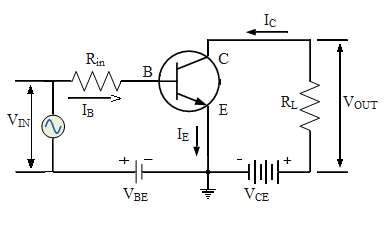
For a common emitter configuration, if $\alpha $ and $\beta $ have their usual meaning the correct relationship between $\alpha $ and $\beta $ is:
A. $\dfrac{1}{\alpha }=\dfrac{1}{\beta }+1$
B. $\alpha =\dfrac{\beta }{1-\beta }$
C. $\alpha =\dfrac{\beta }{1+\beta }$
D. $\alpha =\dfrac{{{\beta }^{2}}}{1-{{\beta }^{2}}}$
Answer
555k+ views
Hint: Common emitter is the configuration of an amplifier. The circuit is assembled in such a way that the emitter is connected between the collector and the base of the amplifier. This emitter is common to both the input and the output of the circuit. The amplifier is also known as a bipolar junction transistor that is used to amplify the input current.
Complete step by step answer:
The common emitter configuration can be understood with more clarity from the diagram given here,

In this type of circuit the current thought the circuit is the sum of the current coming from the collector and the base.
Mathematically,
${{I}_{E}}={{I}_{B}}+{{I}_{C}}$
The ratio of the input base current and the collector current is known as the current gain denoted by$\beta $.
$\dfrac{{{I}_{C}}}{{{I}_{B}}}=\beta $
The current gain of the common emitter amplifier is large.
The ratio of the collector current and the emitter current is known as alpha symbolically represented as $\alpha $
$\dfrac{{{I}_{C}}}{{{I}_{E}}}=\alpha $
From the current gain, the collector current can be written as,
${{I}_{C}}={{I}_{E}}\beta $
By putting the values of the emitter current and collector current in alpha
\[\begin{align}
& \dfrac{\beta {{I}_{B}}}{{{I}_{C}}+{{I}_{B}}}=\alpha \\
& \Rightarrow \dfrac{1}{\alpha }=\dfrac{{{I}_{C}}}{\beta {{I}_{B}}}+\dfrac{{{I}_{B}}}{\beta {{I}_{B}}} \\
\end{align}\]
The ratio of collector current and emitter current is given as $\dfrac{{{I}_{C}}}{{{I}_{B}}}=\beta $
So,
$\dfrac{1}{\alpha }=1+\dfrac{1}{\beta }$
This can be rearranged as,
$\alpha =\dfrac{1+\beta }{\beta }$
This is the relationship between the two terms $\alpha $ and $\beta $.
So, the correct answer is “Option A”.
Note: The output impedance of the CE (common-emitter) amplifier is very high whereas the input impedance of the CE configuration circuit is quite low. When we consider the power gain of such amplifiers it seems to be very high. These parameters are estimated by the current flowing through the collector, base, and emitter and the voltage supplied to the circuit.
Complete step by step answer:
The common emitter configuration can be understood with more clarity from the diagram given here,

In this type of circuit the current thought the circuit is the sum of the current coming from the collector and the base.
Mathematically,
${{I}_{E}}={{I}_{B}}+{{I}_{C}}$
The ratio of the input base current and the collector current is known as the current gain denoted by$\beta $.
$\dfrac{{{I}_{C}}}{{{I}_{B}}}=\beta $
The current gain of the common emitter amplifier is large.
The ratio of the collector current and the emitter current is known as alpha symbolically represented as $\alpha $
$\dfrac{{{I}_{C}}}{{{I}_{E}}}=\alpha $
From the current gain, the collector current can be written as,
${{I}_{C}}={{I}_{E}}\beta $
By putting the values of the emitter current and collector current in alpha
\[\begin{align}
& \dfrac{\beta {{I}_{B}}}{{{I}_{C}}+{{I}_{B}}}=\alpha \\
& \Rightarrow \dfrac{1}{\alpha }=\dfrac{{{I}_{C}}}{\beta {{I}_{B}}}+\dfrac{{{I}_{B}}}{\beta {{I}_{B}}} \\
\end{align}\]
The ratio of collector current and emitter current is given as $\dfrac{{{I}_{C}}}{{{I}_{B}}}=\beta $
So,
$\dfrac{1}{\alpha }=1+\dfrac{1}{\beta }$
This can be rearranged as,
$\alpha =\dfrac{1+\beta }{\beta }$
This is the relationship between the two terms $\alpha $ and $\beta $.
So, the correct answer is “Option A”.
Note: The output impedance of the CE (common-emitter) amplifier is very high whereas the input impedance of the CE configuration circuit is quite low. When we consider the power gain of such amplifiers it seems to be very high. These parameters are estimated by the current flowing through the collector, base, and emitter and the voltage supplied to the circuit.
Recently Updated Pages
Master Class 12 Business Studies: Engaging Questions & Answers for Success

Master Class 12 Economics: Engaging Questions & Answers for Success

Master Class 12 English: Engaging Questions & Answers for Success

Master Class 12 Maths: Engaging Questions & Answers for Success

Master Class 12 Social Science: Engaging Questions & Answers for Success

Master Class 12 Chemistry: Engaging Questions & Answers for Success

Trending doubts
What are the major means of transport Explain each class 12 social science CBSE

Which are the Top 10 Largest Countries of the World?

Draw a labelled sketch of the human eye class 12 physics CBSE

How much time does it take to bleed after eating p class 12 biology CBSE

Explain sex determination in humans with line diag class 12 biology CBSE

Differentiate between homogeneous and heterogeneous class 12 chemistry CBSE




